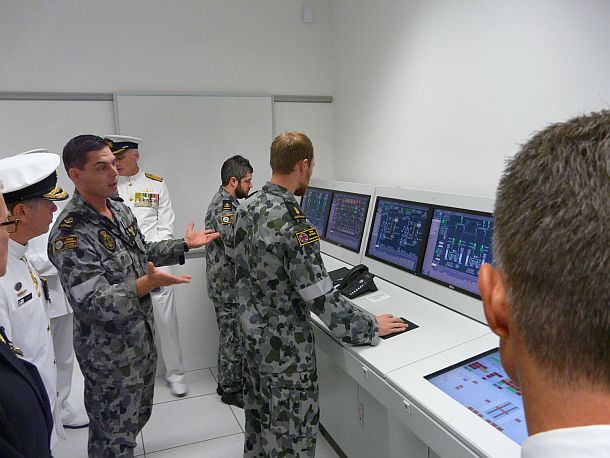A state of the art simulation facility has been opened in Sydney today that will enhance training for Royal Australian Navy technical sailors.
Chief of Navy, Vice Admiral Tim Barrett officially opened the $85 million Navy Training Systems Centre at Randwick Barracks, and said the purpose-built facility would revolutionise how Navy prepares marine and Electronic technicians for their roles out in the fleet.
"This next generation training facility will ensure that Navy can fully utilise the extraordinary capabilities of both the Canberra class amphibious ships and the Hobart class destroyers.," VADM Barrett said.
 LSMTP Cook explains the functions of one of the engineering simulators to gathered dignitaries including VADM Tim Barrett (at left). Credit: ADM (Patrick Durrant)
LSMTP Cook explains the functions of one of the engineering simulators to gathered dignitaries including VADM Tim Barrett (at left). Credit: ADM (Patrick Durrant)
When fully operational, the centre will be able to train up to 300 students at a time, using a combination of simulation and modern training systems.
VADM Barrett said the use of simulation and task specific training tools would reduce Navy's need to conduct elements of training at sea, allowing more sea days for advanced group training and to support Government directed operations.
"Our new amphibious ships and destroyers will be serving Australia's national interests for the next three decades, which is why this centre will play a vital role underpinning the successful operation of these assets."
"I anticipate an expanded use of these assets in the future, as they provide Navy with a fantastic capability at a lower total cost over the life of the ships," VADM Barrett said.
Recognising that Navy's training needs will evolve, the facility has been designed and constructed to be reconfigured for future training needs and additional platforms.
The building has also been constructed with minimal environmetal impact, including energy self sufficiency through 100 rooftop photovoltaic panels.




